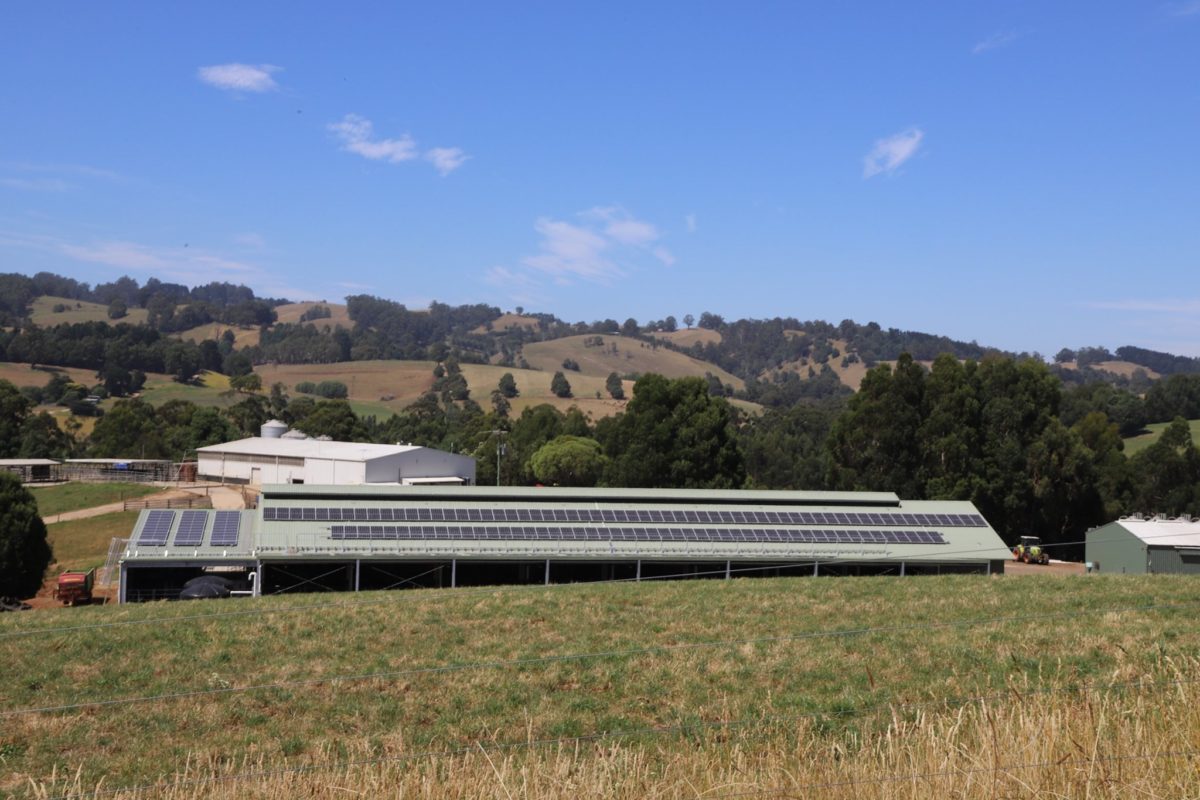If Ellinbank SmartFarm in Gippsland weren’t a research and demonstration facility, it might just install a 400 kW rooftop solar system to reduce its costs and carbon footprint, and achieve the shortest period to payback on investment.
As it is, the long-established agricultural research facility will demonstrate the use cases of no fewer than three solar systems, and deploy wind energy and electricity generated through biodigestion of manure, as part of its mission to help farmers access and understand the benefits of renewables, and at the same time become what may be the world’s first carbon-neutral dairy farm within the next five years.
Around 70% of the carbon emissions of dairy farms are in the form of enteric methane produced by cows as they go about their ruminant way of digesting cellulose.
Professor Joe Jacobs, Research Director with the Victorian Government Department of Economic Development, Jobs, Transport and Resources, estimates that Ellinbank, with its herd of 450-500 milkers, emits the equivalent of just over 2,600 tonnes of CO2 a year, with enteric methane, energy use and manure generating the vast majority of that output.
“We know we can never completely eliminate methane from dairy farming,” he tells pv magazine Australia, “but solar energy offers us the ability to head towards a net-zero emissions target.”
The infrastructure required to make Ellinbank carbon neutral is partly funded through the Victorian Government’s Smarter, Safer Farms initiative.
And the farm will this year become the base of the Agriculture Energy Demonstration and Education program, which is supported via the state Labor Government’s $30 million Agriculture Energy Investment plan, and aims to help farmers increase energy efficiencies and reduce energy costs.
“Farmers are generally some of the most innovative people around,” says Jacobs. “What I think we can do,” he continues, “is demonstrate different technologies so they can identify the potential fit for their farm.”
Ellinbank last year installed a 98 kW solar system on the roof of its dairy shed, coupled with a 100 kWh battery.
Jacobs estimates that this system provides 20-25% of the farm’s energy needs.
Ellinbank’s chill factor
Just as commercial and residential building owners are advised to implement efficiency measures before installing renewable energy systems, Ellinbank sought to reduce its energy use before laying on the solar.
For example, it upgraded the chiller system used to cool the milk on its journey from cows — that have a body temperature of 38-39 degrees Celsius — to the storage vat, where it must be held at 4 degrees.
“Many older dairy systems have the milk arriving at the vat at a high temperature, where it requires a lot of excess energy to chill that volume of milk,” says Jacobs. Ellinbank’s new system more effectively reduces milk temperature en route, so that it’s almost at 4 degrees by the time it reaches the vat.
Ellinbank will also demonstrate the use of a solar array and battery (capacities are yet to be calculated) to power its water treatment plant.
Hills for hydration and pumped hydro
The farm and research institute are not on mains water, but use water from a spring-fed dam to serve both animals and human needs on the combined properties: water is pumped to the highest point on the farm before being treated and flowing down under gravity to provide a clean, pressurised supply.
In addition to its battery supported solar arrays, Ellinbank will demonstrate a solar-powered pumped hydro system using the farm’s naturally undulating topography.
With storage tanks already on hill tops, Jacobs says, “We’re looking to utilise one of those falls to run a small pumped hydro system.”
And a wind turbine or two will soon capture the Gippsland breeze to demonstrate the costs and returns to farmers of wind energy.
A renewable-energy pick and mix
Jacobs says that some generation and storage options may be on the verge of viability for farmers, but in seeing how they can be integrated with new farming efficiency methods, businesses can plan such investments for the near future.
To fulfill its own aspirations for carbon neutrality, Ellinbank will seek to reduce methane emissions by trialling different pasture treatments; adjusting livestock feed mixes and systems of feed delivery; processing manure to capture methane as biogas for energy generation; and use solar PV to generate more clean energy than it needs, to offset its remaining methane emissions.
“We have plenty of scope to increase the solar capacity on the farm,” says Jacobs. Excess energy could feed into the grid or potentially power the offices of the onsite Ellinbank Dairy Research Institute.
As a demonstration facility, this SmartFarm will offer farmers a broad spectrum of renewable energy systems that may suit the topography or business case of their own agricultural properties and processes.
When launching the joint funding initiatives for Ellinbank, Victoria’s Minister for Agriculture, Mary-Anne Thomas, said “An important part of the work being done here is making it accessible to industry so that knowledge can immediately be put to use.”
This content is protected by copyright and may not be reused. If you want to cooperate with us and would like to reuse some of our content, please contact: editors@pv-magazine.com.









By submitting this form you agree to pv magazine using your data for the purposes of publishing your comment.
Your personal data will only be disclosed or otherwise transmitted to third parties for the purposes of spam filtering or if this is necessary for technical maintenance of the website. Any other transfer to third parties will not take place unless this is justified on the basis of applicable data protection regulations or if pv magazine is legally obliged to do so.
You may revoke this consent at any time with effect for the future, in which case your personal data will be deleted immediately. Otherwise, your data will be deleted if pv magazine has processed your request or the purpose of data storage is fulfilled.
Further information on data privacy can be found in our Data Protection Policy.